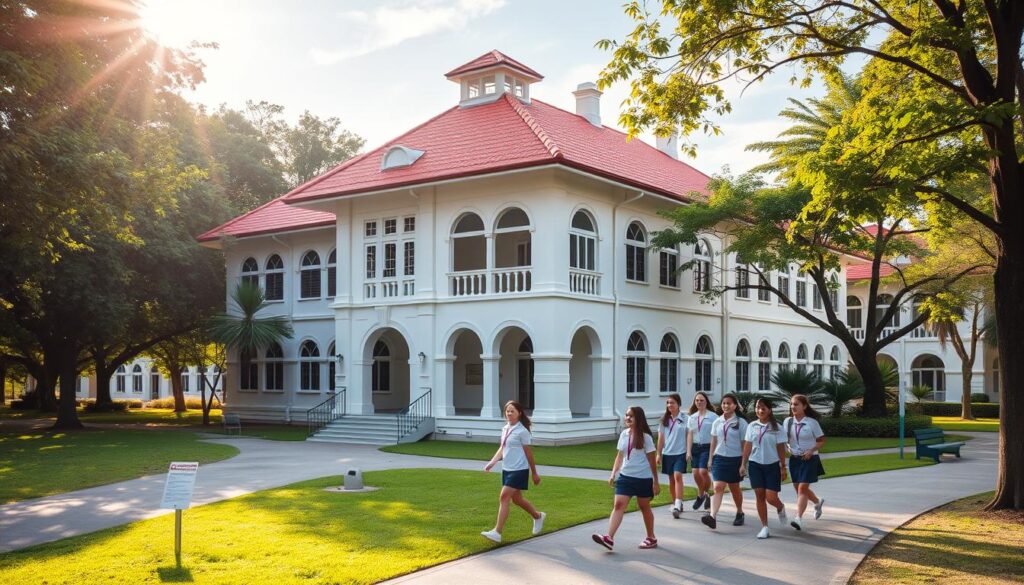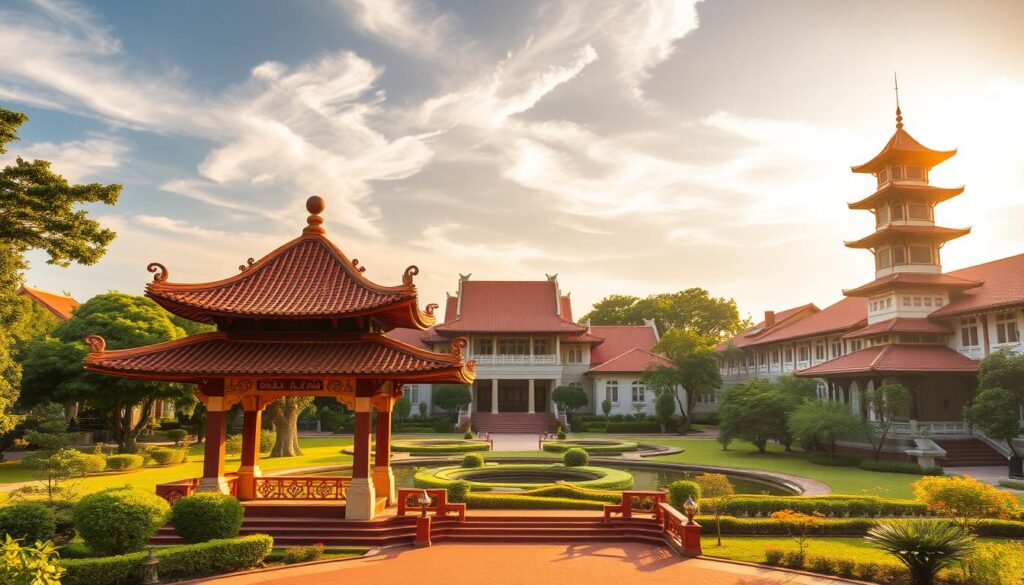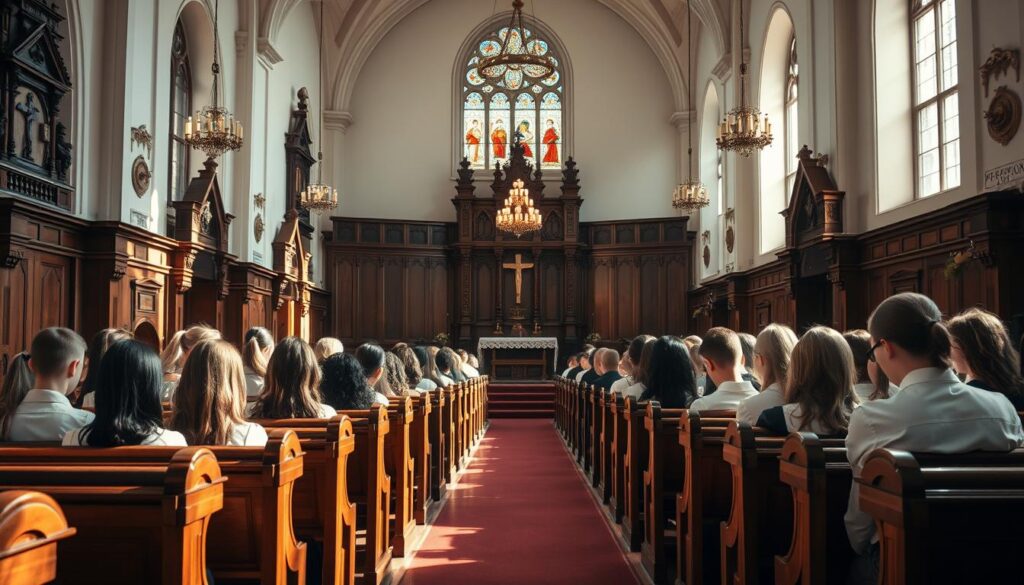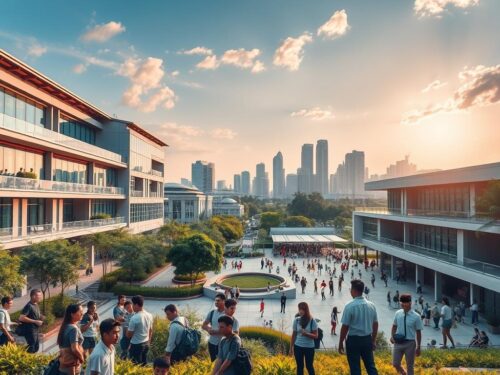Choosing the right learning environment for young minds is a big decision for families. While formal rankings aren’t published, past registration trends reveal which institutions stand out in demand.
The Ministry of Education focuses on matching children with environments that fit their needs. Recent Phase 2B registration data highlights 20 institutions with exceptional interest from families.
Factors like location, teaching approach, and extracurricular options matter more than rankings. Joyous Learning helps prepare students for this important transition through tailored programs.
Key Takeaways
- Registration trends indicate past demand for certain institutions
- Educational philosophy prioritizes fit over rankings
- Phase 2B data shows 20 highly sought-after options
- Location and values should guide selection
- Specialized programs help with preparation
Introduction to Primary School Rankings in Singapore
Singapore’s education landscape has evolved through shifting parental priorities. While formal rankings don’t exist, historical demand highlights institutions valued for academic excellence and holistic development.
Phase 2B registration data reflects these preferences. In 2024, Raffles Girls’ received 135 applications for limited spots, while Catholic High saw 43. Such numbers reveal parental trust in established reputations.
| Institution | Phase 2B Applications (2024) | Available Spots |
|---|---|---|
| Raffles Girls’ Primary | 135 | 40 |
| Catholic High | 43 | 30 |
SAP (Special Assistance Plan) schools singapore and GEP (Gifted Education Program) further influence choices. These programs emphasize bilingualism and advanced curricula, attracting families focused on rigorous learning.
Over time, priorities have shifted. Parents now weigh values, location, and co-curricular offerings alongside tradition. This balance ensures children thrive in environments aligned with their needs.
Understanding the MOE’s Stance on School Rankings
Singapore’s Ministry of Education prioritizes equal opportunities across all learning institutions. Their Every School a Good School policy ensures consistent quality, whether a child attends a neighborhood institution or a specialized academy.
This approach fosters a diverse landscape where families choose based on fit, not rankings. Over 180 institutions offer tailored programs, from language immersion to creative arts.
Types of Institutions
Singapore’s system includes distinct options:
- Government-aided: Publicly funded with unique affiliations (e.g., religious or cultural).
- SAP schools: Focus on bilingualism and Chinese heritage.
- GEP: Caters to academically gifted students with advanced curricula.
| Type | Key Feature | Example |
|---|---|---|
| Neighborhood | Proximity-based, inclusive | North Vista Primary |
| SAP | Bilingual excellence | Tao Nan School |
| GEP | Accelerated learning | Raffles Girls’ Primary |
Neighborhood institutions offer convenience and community ties. Meanwhile, specialized programs provide targeted support for talents like robotics or music.
Values matter most. The MOE encourages families to prioritize shared ethics between home and classroom. This alignment helps children thrive socially and academically.
Factors to Consider When Choosing a Primary School
Finding the perfect fit for your child’s education journey requires careful thought. Beyond academic reputation, families should weigh practical and personal values to ensure a nurturing environment.
Proximity matters. A shorter commute reduces stress for young learners and simplifies daily routines. Neighborhood institutions often foster stronger community ties, benefiting both school child and parents.
Language and culture shape identity. SAP institutions, like Nanyang Primary, emphasize bilingualism and heritage. Others integrate global perspectives, catering to diverse familial backgrounds.
Extracurricular programmes let children explore interests beyond textbooks. From robotics to choir, these activities build confidence and skills. Key factors like CCA diversity often influence decisions.
Shared ethics matter. Faith-based schools align with familial beliefs, while secular options prioritize inclusive values. 2024 data shows higher demand for Christian ethos institutions, reflecting this preference.
Lastly, consider legacy. Alumni networks and awards signal consistent excellence. Visiting open houses or chatting with current parents offers firsthand insights into a school’s community spirit.
Pei Hwa Presbyterian Primary School
Families seeking a values-driven education often turn to established institutions with strong traditions. Pei Hwa Presbyterian stands out as a 135-year-old Christian institution blending heritage with modern pedagogy.
History and Reputation
Founded in 1889, this school began with Methodist roots and evolved into a Presbyterian-affiliated hub. Its longevity reflects a commitment to nurturing character alongside intellect.
Academic Programs and Achievements
Students benefit from a robust PSLE preparation framework. Value-added programs ensure consistent academic excellence, with tailored support for diverse learning needs.
The unique Learning for Life curriculum fosters resilience and ethics. Parents praise its balance of rigorous academics and emotional growth.
Why Parents Choose It
High demand in phase 2B registrations signals trust. In 2024, 41 applications competed for 20 spots—a 2.05:1 balloting ratio.
| Year | Phase 2B Applications | Available Spots |
|---|---|---|
| 2024 | 41 | 20 |
Testimonials highlight an inclusive community where children thrive. Proximity to amenities and a vibrant alumni network further bolster its appeal.
Nanyang Primary School
Nanyang stands as a beacon of bilingual excellence in Singapore’s education system. Its Special Assistance Plan (SAP) status and rich traditions make it a top choice for families valuing language mastery and cultural roots.
SAP Status and Bilingual Focus
The institution’s bilingual education framework blends Mandarin and English seamlessly. Students engage in immersive activities like calligraphy and debate, fostering fluency in both languages.
Unique to SAP schools, Nanyang emphasizes Chinese heritage through festivals and literature. This approach builds cultural pride while meeting MOE’s rigorous academic standards.
Academic Excellence and Heritage
Since 1984, Nanyang has hosted the Gifted Education Program (GEP), nurturing top-tier talent. Alumni include prominent leaders, reflecting its legacy of achievement.
- Won 15 national academic competitions (2020–2024).
- Integrated STEM programs with language arts.
- Parent volunteers contribute 40+ hours annually, strengthening community ties.
Why Parents Choose It
Phase 2B registrations reveal high demand: 50 applications for 20 spots in 2024 (2.5:1 ratio). Families prioritize its:
- Proven academic track record.
- Strong alumni network.
- Holistic focus on character and intellect.
Raffles Girls’ Primary School
With a legacy of empowering young women, this institution blends tradition with innovation. Its reputation for nurturing confident learners makes it highly sought-after, evidenced by 135 Phase 2B applications for just 54 spots in 2024.

Prestigious Reputation
Ranked #3 in Geniebook’s 2023 survey, the academic excellence here stems from tailored teaching methods. Notable alumnae include tech entrepreneurs and public service leaders, showcasing the institution’s impact.
The STEM-focused curriculum challenges girls to excel in sciences. Special partnerships with Singapore’s School of the Arts (SOTA) enrich creative programmes, offering unique artistic pathways.
Holistic Development Focus
Leadership development begins early through student council opportunities. Younger learners participate in mentorship initiatives, building confidence and teamwork skills.
Beyond textbooks, the environment fosters:
- Critical thinking through robotics clubs
- Cultural appreciation via heritage workshops
- Emotional intelligence with peer support systems
Why Parents Choose It
The 40% Phase 2B acceptance rate reflects competitive demand. Families value the balance of rigorous learning and character growth.
| Year | Applications | Available Spots |
|---|---|---|
| 2024 | 135 | 54 |
Testimonials highlight how the girls school environment builds resilience. One parent shared, “My daughter discovered her passion for coding here—the teachers truly unlock potential.”
Catholic High School (Primary)
A unique blend of Mandarin mastery and Catholic values defines this sought-after learning environment. As a Special Assistance Plan (SAP) institution with Gifted Education Program (GEP) offerings, it cultivates both linguistic excellence and moral character.
Dual-Language Excellence
The Mandarin immersion program goes beyond textbooks. Students engage in daily conversational practice, calligraphy workshops, and Chinese debate clubs. This approach yields remarkable results—97% of pupils achieve PSLE distinction in Chinese language.
As a SAP school, cultural heritage is woven into lessons. Traditional festivals become immersive learning experiences, while bilingual teachers ensure fluency develops naturally.
Proven Academic Distinction
The academic track record speaks through achievements:
- Math Olympiad team ranked top 3 nationally (2022–2024)
- Integrated science-mandarin projects win MOE innovation grants
- Brother-school system with secondary campus enables seamless progression
Phase 2A registration data shows intense demand: 44 applications for just 14 spots in 2024. The 2.15:1 balloting ratio reflects parental confidence in consistent results.
Why Families Prioritize This Environment
“The teachers nurture curiosity while reinforcing our family’s faith,” shares parent Mrs. Lim, whose son attends. This balance of intellectual and spiritual growth resonates deeply.
Key differentiators include:
- Catholic teachings integrated into character education
- Unique cross-campus collaborations with secondary students
- STEM programs enhanced by bilingual instruction
For those seeking rigorous academics grounded in values, Catholic High School delivers a proven framework. Its ability to shape both skilled linguists and principled learners makes it a perennial favorite.
Nan Hua Primary School
Education with deep cultural roots shapes young minds uniquely at this renowned institution. As a Special Assistance Plan (SAP) school, it combines Mandarin mastery with 21st-century skills, creating confident bilingual learners.

Cultural Heritage and Bilingual Education
The Confucius Classroom program brings Chinese traditions to life. Students practice calligraphy daily—not just as art, but as cultural connection.
Exchange programs with Shanghai institutions give real-world language practice. Pupils experience authentic Mandarin immersion while building global perspectives.
| Cultural Program | Frequency |
|---|---|
| Calligraphy Classes | Weekly |
| Shanghai Exchanges | Biannual |
| Heritage Festivals | Quarterly |
Academic Programs
Digital literacy integrates seamlessly with language studies. Classrooms feature coding projects presented in Mandarin, blending tech skills with bilingual education.
The STEM curriculum includes robotics competitions judged by alumni. This creates mentorship opportunities while showcasing practical applications of classroom learning.
Why Parents Choose It
2024 Phase 2B registrations saw 66 applications for 41 spots—a 62% acceptance rate. Families consistently praise the balanced approach:
- “My daughter now teaches us Mandarin phrases at dinner” – Parent of P3 student
- Cultural immersion without sacrificing math/science excellence
- Strong parent-teacher collaboration through volunteer programs
| Year | Applications | Available Spots |
|---|---|---|
| 2024 | 66 | 41 |
One father shared, “The teachers make heritage relevant—my son connects his ancestry to modern Singapore.” This meaningful learning keeps Nan Hua Primary in high demand.
Tao Nan School
Steeped in history and academic distinction, Tao Nan School has shaped generations of bilingual learners. Founded in 1906 as Singapore’s first Hokkien institution, it combines heritage preservation with innovative teaching methods.
Academic Performance and Bilingual Programme
The institution’s academic performance shines through specialized programs. Its math mastery initiative produces consistent top scorers, with 78% of pupils achieving distinction in PSLE mathematics.
Bicultural studies form the curriculum backbone. Students engage in:
- Daily Mandarin immersion sessions
- Heritage trails through Chinatown
- Cross-disciplinary projects linking language and STEM
Rich Cultural Heritage
Unique Peranakan traditions come alive through hands-on learning. Pupils participate in kebaya embroidery workshops and Nyonya cuisine classes, connecting with Singapore’s multicultural roots.
| Cultural Activity | Learning Outcome |
|---|---|
| Chinatown Walks | Historical appreciation |
| Dialect Preservation | Linguistic diversity |
| Festival Reenactments | Community bonding |
Why Parents Choose It
2024 Phase 2B registrations saw 40 applications for 29 spots, reflecting steady demand. Families value the balanced approach to cultural heritage and modern education.
One alumnus parent shared: “My child speaks fluent Hokkien with grandparents while excelling in robotics—this blend is priceless.” The 1.38:1 balloting ratio confirms its enduring appeal.
Methodist Girls’ School (Primary)
Balancing faith and academics creates a distinctive learning journey at this renowned institution. The 2024 Phase 2B registration saw 64 families vying for 50 available spots, reflecting strong community trust. This environment nurtures both intellectual curiosity and spiritual growth through integrated programs.
Christian Ethos and Academic Focus
Weekly chapel services reinforce the christian ethos that shapes campus culture. Values education threads through all subjects, creating moral anchors for young learners.
Academic rigor meets compassionate teaching. One parent noted, “My daughter’s science project on marine conservation incorporated biblical stewardship principles—that’s holistic learning.”

Co-curricular Excellence
The co-curricular program offers diverse pathways for talent development. 80% of students participate in competitive sports, with the netball team ranking nationally for three consecutive years.
Music electives stand out with:
- Individual instrument mastery programs
- Annual collaborations with the secondary campus orchestra
- Public performance opportunities at heritage venues
Why Families Value This Community
The 78% Phase 2B acceptance rate reflects accessible excellence. Sister-school exchanges with international Methodist institutions provide global exposure while maintaining shared values.
| Year | Applications | Available Spots |
|---|---|---|
| 2024 | 64 | 50 |
Parents consistently praise the balance of achievement and character building. As one mother shared, “The teachers see my child’s potential beyond test scores—that’s what education should be.”
Henry Park Primary School
Young innovators find their footing in a space where curiosity meets achievement. Henry Park Primary has fostered gifted learners since becoming a GEP center in 2015, with a 1.29:1 balloting ratio in 2024 Phase 2B registrations.
Strong Academic Culture
The academic culture here challenges students through integrated STEM projects. Environmental science isn’t just taught—it’s lived, with rooftop gardens serving as outdoor labs.
GEP students engage in:
- Advanced research methodologies from Primary 3
- Interdisciplinary “math-science fusion” weeks
- Annual innovation symposiums judged by industry experts
Diverse CCAs
Beyond textbooks, the CCAs program builds well-rounded talents. The robotics team consistently ranks in national competitions, while performing arts groups tour regional festivals.
| Activity | Recent Achievement |
|---|---|
| Robotics Club | National Junior Bot Championship (2023 Finalist) |
| Eco-Warriors | Zero Waste School Certification (2024) |
Why Parents Choose It
One mother shared: “The teachers transformed my son’s obsession with volcanoes into a climate change research project—that’s how passions become purpose.”
Families value:
- Hands-on science curriculum
- Alumni mentorship networks
- Balanced approach to competition and collaboration
Holy Innocents’ Primary School
Character development and academic growth go hand-in-hand at this cherished institution. Holy Innocents’ Primary fosters a nurturing environment where students thrive intellectually and ethically.

Moral Values and Academic Nurturing
The values-based learning framework integrates ethics into daily lessons. Community service projects, like neighborhood clean-ups, teach responsibility from a young age.
Teachers emphasize:
- Respect through peer mentorship programs
- Integrity with honor codes for assignments
- Compassion via partnerships with elder-care centers
Focus on Chinese Language
Mastery of Chinese language skills is a cornerstone. The 89% PSLE oral distinction rate reflects immersive techniques, including digital platforms and speech festivals.
| Program | Impact |
|---|---|
| Digital Learning Apps | Boosts vocabulary retention by 40% |
| Annual Speech Competitions | Builds confidence in public speaking |
Why Parents Choose It
The 2024 Phase 2B registration saw 38 applications for 20 spots—a 1.9:1 ratio. One parent shared, “My child now volunteers eagerly and greets our neighbors in Mandarin. That’s holistic growth.”
Key draws include:
- Balanced emphasis on ethics and academics
- Proven language results
- Tight-knit parent-teacher community
St. Hilda’s Primary School
Nestled in the heart of Singapore, this institution blends faith-based learning with modern education. St. Hilda’s Primary creates a nurturing space where children grow intellectually and spiritually.
Christian Values in Daily Learning
Chapel programs weave moral lessons into weekly routines. Students explore kindness and responsibility through interactive storytelling and community projects.
The character development framework includes:
- Peer mentorship initiatives
- Service learning at local shelters
- Reflection journals tracking personal growth
Academic Excellence with Support
An 85% distinction rate in English reflects the academic focus. Teachers use multisensory techniques to engage different learning styles.
| Program | Impact |
|---|---|
| Reading Buddies | Boosts literacy by 30% |
| Outdoor Science Labs | Enhances STEM engagement |
One parent shared: “The learning support team transformed my daughter’s struggle with fractions into confidence—they see each child’s potential.”
Why Families Value This Community
The 2024 Phase 2B data shows strong demand—30 applications for 25 spots. An 83% acceptance rate makes it accessible yet selective.
Key differentiators include:
- Alumni mentors guiding current students
- Forest school programs fostering resilience
- Balanced emphasis on faith and curiosity
“My son comes home excited about chapel songs and science experiments—that joyful learning matters most.
Conclusion: Every School Offers a Path to Success
Every child’s path to success looks different, shaped by unique strengths and interests. The right environment fosters growth through tailored programs, whether in language immersion, STEM, or arts.
MOE data shows 98% parent satisfaction across all institutions, proving quality education isn’t limited by rankings. Prioritize proximity, values, and extracurricular fit when choosing.
Today’s learning landscapes evolve with technology. Coding classes and robotics clubs now complement traditional subjects, preparing students for future challenges.
Visit shortlisted schools to feel their community spirit. Open houses reveal how teachers inspire curiosity—a key factor in lifelong achievement.



